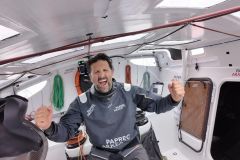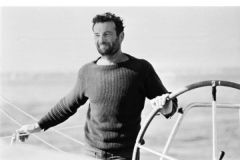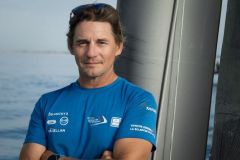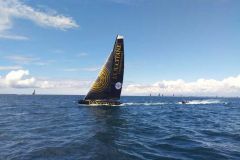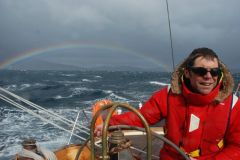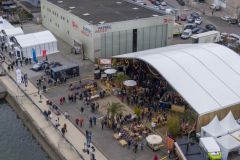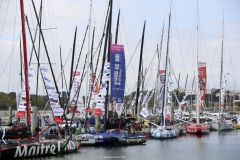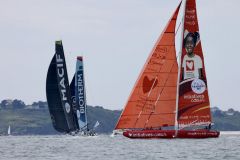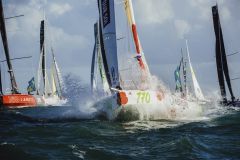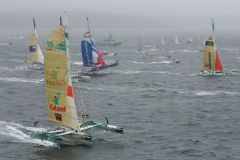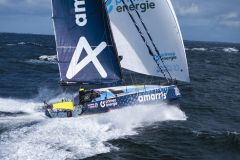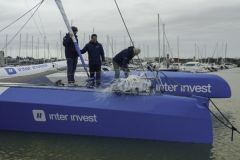After several years on the IMOCA circuit, and a Vendée Globe victory, Vincent Riou is back racing with a solo project. He is now a member of the Class40, and for the occasion has built a boat in the colors of the Pierreval âeuros Goodplanet Foundation, distinguished from the others by its architectural choices.
To begin with, why this desire to return to racing? And why in a Class40?
I was keen to get back on the water following my retirement from IMOCA racing in 2018. I imagined doing Figaro racing, but things didn't work out and I injured my back, which penalized me. I've continued to sail double-handed and crewed on a number of supports, including Ocean Fifty, and Class40.
Apart from the IMOCA, the two other pro series are the Ocean Fifty and the Class40. The Class40 suited me well, because there are prototypes and a lot of things to do. The program is also easier to understand. The Ocean Fifty class has a program that changes, and is known at the last minute, which can be complicated when you have a partner to promote.
Class40 was similar to what I'd done before. There are some great competitors and a fine line-up. I made this choice and I'm delighted.

Are Class40s really less demanding than IMOCAs? Especially when sailing single-handed?
They're all committed boats. Sailing isn't very complicated. Up to 15 knots, it's all about finesse and feel. Beyond that, it's committed. A Class40 is less engaging than an IMOCA, but it's still sporty.
I stopped racing IMOCA voluntarily. I'd already done 15 years. The big race in this class is the Vendée Globe, and I no longer had the motivation to do it. I felt I'd come full circle.
Class40 has a high level, great racers and a big fleet. There are prototypes and intelligent class rules. It's also less project management. It's easier to sail, there's more sailing volume, no big teams like in IMOCA, where there's a lot of HR. It takes a lot of time, and it's not the easiest thing to manage. Class40 ticked all the boxes, with crewed, double-handed and solo sailing. It's diversified.
How did you decide on the design of your Class40 and why?
The reason is simple. It's still racing, so the idea is to go faster than your mates. By sailing a lot of boats and going through the rule book, which is very intelligent, I thought differently about how to make a more efficient boat. I got the idea from watching other boats sail, and the problem revolved around appendages. I also benefited from my IMOCA experience.
At first, the boats were simple. Then we added asymmetric daggerboards, then tilt in the keel, and we had to figure out how to optimize all this and gain in performance. Reflecting on this data and studying the rule that allowed interceptors and trimmers, we opted for a single rudder and a trimmer.
It's original, because it's the first, bearing in mind that my boat is 203 and there have been 202 before. It's not going to be an easy boat for everyone, but it's intellectually interesting, as it's not bad for speed.
The appendages are always with us, so we're looking for speed through the sails. You have to find that extra parameter to go fast. It's an interesting boat to learn and master.
As for the Pogo S4, I made this choice for 3 reasons. Guillaume Verdier had already developed trimmer keels for America's Cup monohulls. It's a boat built in a local yard close to my home, which I know well. Finally, the hull of the Pogo S4 was the one that best suited my concept. I watched a lot of boats sailing, hulls... The best thing would have been to design a hull around this characteristic. But that would have been a risk for me, and I didn't have the means, so I looked at what already existed and chose this one. All the planets aligned for the Pogo S4.
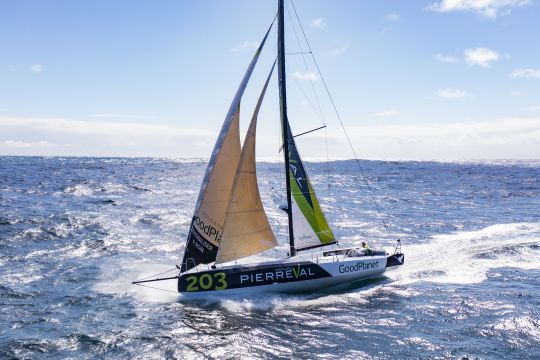
What are the advantages and disadvantages of a trimmer?
The keel is smaller in surface area, because a flap makes it asymmetrical, and more efficient than a symmetrical profile. This makes for a more or less load-bearing profile, which can carry more or less than its surface area, drift less upwind and drift more on certain points of sail. This has an effect on wind angles and performance.
And what about monosafran?
On a boat like this, it's almost always a disadvantage. The advantage is that you don't have to hoist it up, which saves you a lot of maneuvering. The disadvantage is that the rudder is bigger, so if you're very gited, you'll never go faster than with a double rudder. So you need a hull with a higher righting moment to stay flatter. The boat's trim and balance won't be compensated for by a rudder that allows you to go straight ahead. There's no miracle solution in architecture.
I chose the compromise of performance versus handling. I clearly know that on certain points of sail and in certain weather conditions, it will be more complicated to handle than some Class40s. In the end, you have more performance all the time, but you have to be able to manage it.
I've already sailed with it quite a bit, and it works well. We're less in the clean flow of the hull to steer it, but it works. Upwind, it's a little better, even if the keel is smaller. When we're sailing on the beam, the boat drifts less than a standard boat; we make it move forward on its axis. There's less hull drag, so it doesn't crab, but moves along its own axis. We hope to go faster.
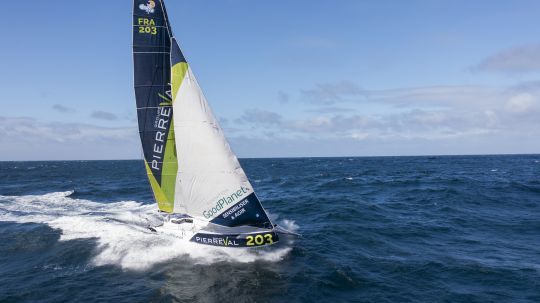
You've just launched your boat. How do you feel about this first race aboard? Do you already have the keys in hand? What about reliability?
Above all, I'm going to concentrate on taking things in hand to finish The Transat. It's a committed race, and my number one objective. I don't have many confrontations with the others. I'm in a development boat, and I believe in it, otherwise I'd have done it differently. Now, I'm waiting for a lot of answers to see if the concept we came up with with the Verdier firm works. We'll have the answer in a few days.
For reliability, I've used my experience and that of the people I work with, and we've got quite a lot. Now, it's a first. I've never started a race with so little confrontation with the rest of the fleet. As for the boat, it's the 10th built, and as Xavier Macaire showed by winning a race, it works well. What we don't know is the boat's steering ability.
Why take part in the Transat CIC, given that there was also the Niji40 a few days ago. Do you have a preference for solo sailing?
The Niji40 is certainly a great race, but there are many transatlantic races in Europe and the West Indies, and only one transatlantic race in Europe and New York. The U.S. East Coast is a beautiful place, even if it comes at a price. It's also more convenient to take part in the Quebec St-Malo, which I'll be doing next.
I've already taken part in this race in 2016, when I finished second in the IMOCA class. It's a race I really enjoy.
Often, the beauty of events such as the Vendée Globe, the Route du Rhum and The Transat lies in the commitment they require.
The Transat is a race that has been struggling for some time. It was taken over by Marc Turner, the last two editions started in England, and the last one was cancelled because of Covid. It's coming back to Lorient, and that's really nice, because the town has put Tabarly to good use. A departure from Lorient and an arrival in New York, it's a great gamble. It would be a shame not to support the organizers, not to bring it to life.
Class40 is a pro-am class, so there's something for everyone. I understand that not everyone wants to do The Transat.
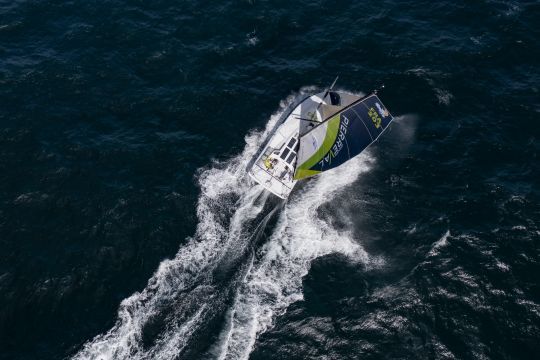
What is your objective for this first return to solo competition with your own project?
There's an idea of competition when you make architectural choices, but my position is strange, because I don't know how to position myself. But I'm not any more worried. I'll be able to make choices and navigate. I want to get to New York. Then there's the Quebec St-Malo.
There are more and more people at the races, and you're not always sure if you're going to take part. You have to show your credentials. When you have sponsors and a program, you have to stick to it. My project ends with the Route du Rhum 2026, so I have to take that into account. If we've made the right choices, my performance will be there, or not. I want to enjoy myself and sail well.
Could a round-the-world trip in a Class40 be part of your future program?
Not today, but it's not a bad idea. It's a bit early for me for many reasons, partner and personal. In another cycle, why not. You still have to do a few things on the boats, but it's possible. And that's what I like about the Class40s, we go to different places, the Azores, Quebec. So maybe, no doubt one day.





